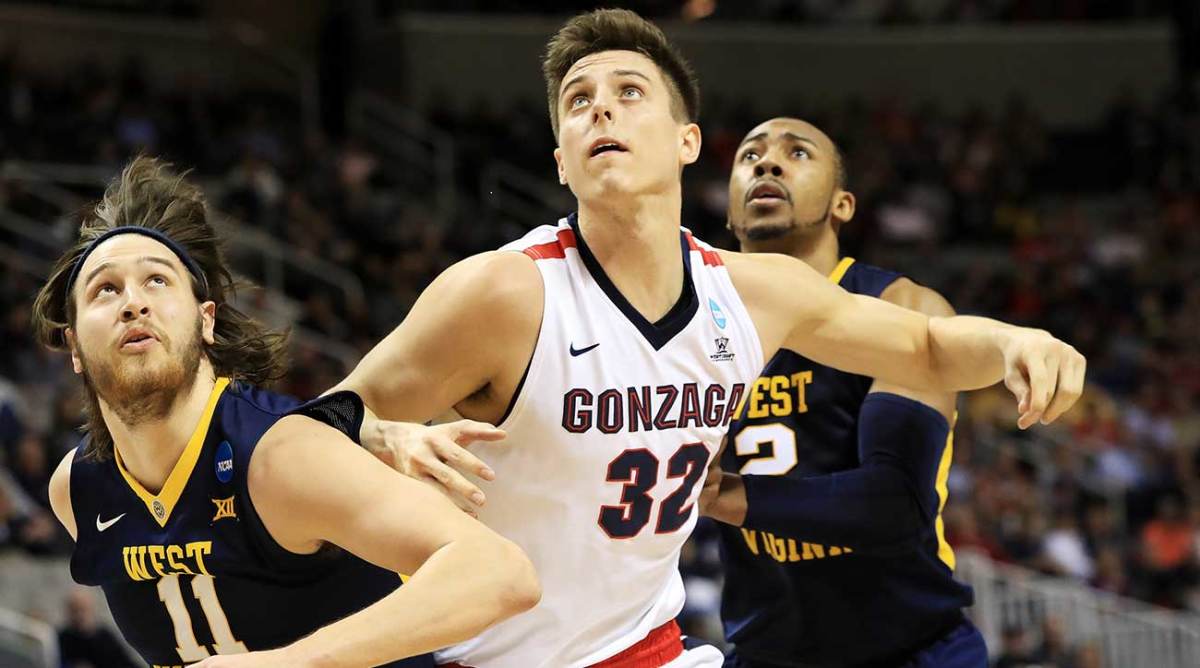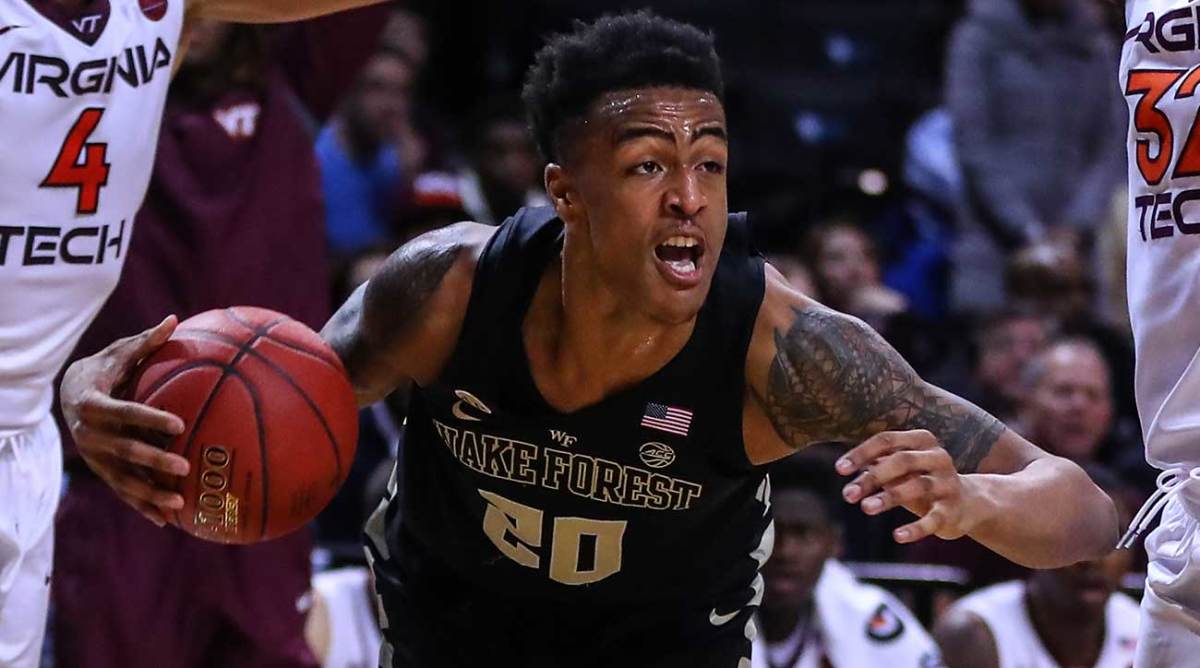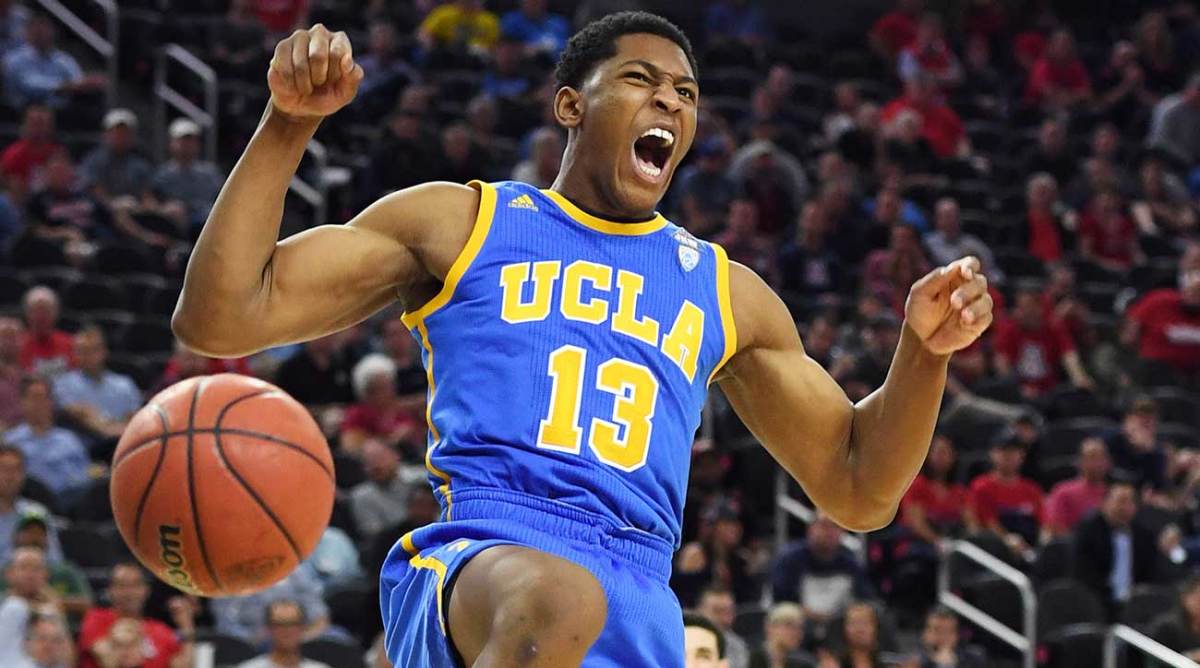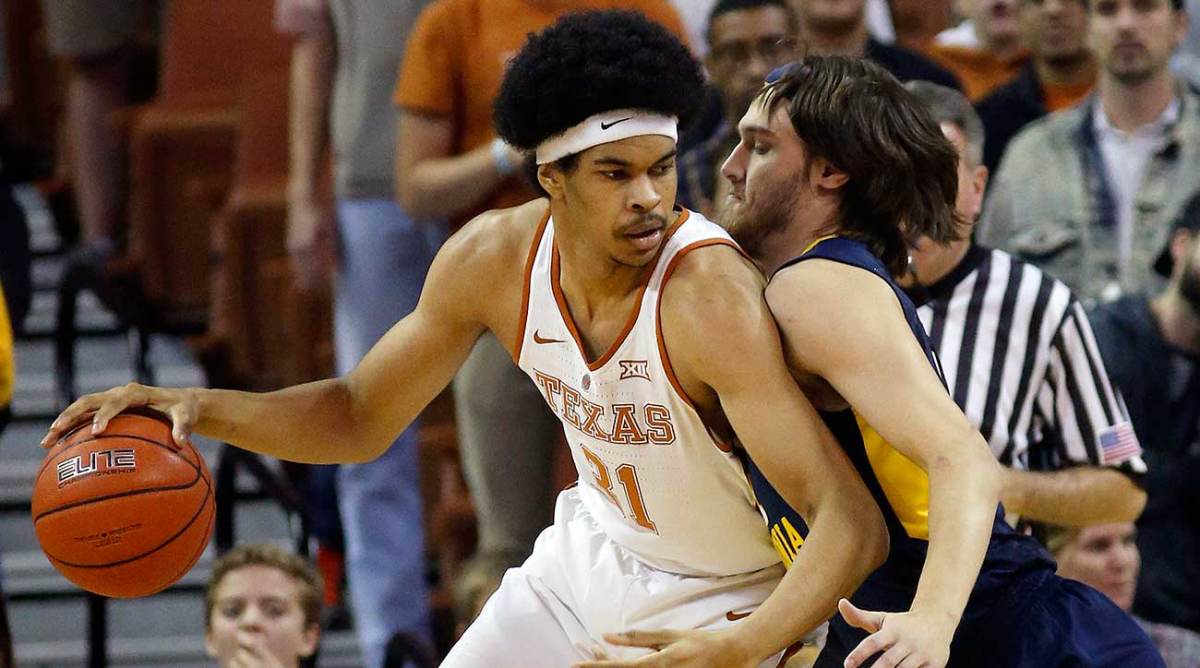2017 NBA Draft: Ranking The Best Bigs Available

With the 2017 NBA draft quickly approaching, The Crossover's scouting department provides in-depth scouting reports for the top 15 big men in the 2017 NBA draft.
While this year's class is loaded with talented big men who can stretch the floor, few possess the experience necessary to make an immediate impact. Many of the prized big men, including Gonzaga's Zach Collins, Duke's Harry Giles, and UCLA's Ike Anigbogu have only the smallest of sample sizes to go off of. That said, mere flashes alone have lottery teams considering their NBA futures.
Without further ado, here's a breakdown of the best big men in this year's draft, along with brief breakdowns on their backgrounds, strengths and weaknesses.
(Research and analysis provided by Jeremy Woo, Jake Fischer, Chris Johnson and Michael Shapiro.)
• MORE DRAFT: Mock Draft 6.0 | Best Big Men | Best Wings | Draft Rumors

1. Zach Collins, Gonzaga (Freshman)
Stats: 10.0 PPG, 5.9 RPG, 1.8 BPG, 65.2% FG, 47.6% 3FG
Bio: Collins was a McDonald’s All-American, but flew a little bit under the radar in picking Gonzaga. Of course, that didn’t last—his impressive play in a reserve role culminated during a March tournament run that turned heads and solidified his status as a lottery pick. With good size, applicable skills and mobility around the basket, Collins is a defensive-minded big man whose offense has a chance to catch up and make him extremely valuable.
Strengths: Collins has good rim-protecting instincts, timing as a shot-blocker and a soft shooting touch that has some scouts believing he can be a stretch–four, a scenario that increases his upside significantly. Versatile 7-footers are hard to find, and Collins checks a lot of boxes and put up ridiculous per-minute numbers last season. He should be able to add muscle and become a solid, starting-caliber big man down the road.
Weaknesses: There’s still not a huge sample size to look at with Collins, and plenty of prospects have benefited from recency bias during the draft only to lose steam once they reach the league. He’s inexperienced, relatively speaking, and can be mistake-prone. Collins has a pretty well-rounded profile, but the risk is in the unknown.
2. Lauri Markkanen, Arizona (Freshman)
Stats: 15.6 PPG, 7.2 RPG, 0.5 BPG, 49.2 FG%, 42.3 3P%
Bio: The highest-rated European prospect of the 2016 recruiting class, Markkanen did not disappoint during his freshman season at Arizona. The 7’0” sharpshooter from Finland truly burst onto the scene with a dominant performance at last year’s U20 European Championships. His strong play in the Pac-12 earned Third-Team All-American honors from multiple media outlets and garnered a first-team all-conference selection.
Strengths: Markkanen is arguably the premier shooter in the draft. He drained 42.3% of his attempts from the outside at Arizona, hoisting 4.4 per game. The NBA three-point line also won’t pose a challenge for his fluid mechanics. He’s a good rebounder, although he won’t make a living on the offensive glass. Scouts who evaluated his European performances also rave about his ability to handle the ball, both in transition and in half-court isolation settings. The thought of Markkanen running 4-5 pick-and-rolls with Karl-Anthony Towns or Kristaps Porzingis could induce nightmares for opposing NBA coaching staffs.
Weaknesses: What promise Markkanen brings on the offensive end, he equally lacks on the other. The defensive boards he gobbled appear translatable on tape, but he will struggle defending in space at the next level. For someone who attempted over 13 shots a game at Arizona, Markennan was an extremely limited playmaker, dishing just 32 assists in 37 games. There’s a legitimate fear he will never grow into more than just a knockdown shooter who spaces the floor for his teammates. That’s certainly a valuable player in the modern NBA, but those picking in the top 10 are certainly hoping to add a prospect who can provide far more.

3. John Collins, Wake Forest (Sophomore)
Stats: 9.2 PPG, 9.8 RPG, 1.6 BPG, 62.2 FG%
Bio: Collins rocketed up draft boards last year after a stellar offensive campaign that earned him the ACC’s Most Improved Player award. The sophomore dominated the paint in conference play, averaging over 20 points per game. At just 19, Collins isn’t a completely polished player, but he’s shown enough in two years at Wake Forest to be considered a top-15 prospect.
Strengths: A skilled-rum runner with some serious leaping ability, Collins is one of the best offensive big men in the draft. He’s comfortable rolling to the rim off screens, with a deft touch inside the paint. He’ll run the floor with abandon, and is more than ready to live above the rim in the transition. Collins is also skilled in the post. He’s got clean feet for someone so young, able to use an array of moves to score with his back to the basket.
Weaknesses: Collins’s defensive shortcomings will be his biggest hurdle upon entering the league. He found himself lost in space too often at Wake, allowing easy drives to the hoop or open lanes for cutters. Collins struggled to hedge or switch effectively on the pick-and-roll—which will severely limit his NBA ceiling unless rectified—and he often looked unengaged or undisciplined. It’s not all bad news, though. Collins has an impressive blend of length and leaping ability—he can become a solid defender if he rids himself of his bad habits.
NBA Mock Draft 6.0: The 76ers Are On The Clock
4. Harry Giles, Duke (Freshman)
Stats: 3.9 PPG, 3.8 RPG, 0.7 BPG, 57.7 FG%
Bio: Once considered the top overall prospect in high school basketball, Giles’s star had dimmed considerably by the time he finally took the court at Duke. He missed the first 11 games of his one season in Durham after undergoing a knee scope, his third knee procedure in as many years. Giles saw action in 26 games but played in only 20.3% of available minutes, according to Kenpom.com, and only twice hit double digits in scoring. He played 15 total minutes in the Blue Devils’ two NCAA tournament games.
Strengths: If Giles ever recaptures the qualities that made him a can’t-miss recruit in high school, he has all the makings of an elite modern big man. At his best, he can stay in front of quicker ball handlers, protect the rim and end possessions by beating opposing big men on the glass. He also does well diving to the rim, making him a promising partner for screen-and-roll sets.
Weaknesses: Even if his knee checks out this summer, questions will persist over Giles’s durability long-term. His one college season didn’t offer much reassurance that he’s on track to reclaiming his status as one of the nation’s best young big men. Giles also failed to demonstrate that he’s made significant strides as a shooter; he did not attempt a single three-pointer and made half of his 24 free-throw attempts at Duke.
5. Justin Patton, Creighton (Freshman)
Stats: 12.9 PPG, 6.2 RPG, 1.4 BPG, 67.6% FG, 51.7% FT
Bio: Patton entered the season as an unknown after redshirting his freshman year, preceded by a flash-recruitment that kept the Omaha native close to home. Creighton leaned on him heavily and he produced, putting up huge efficiency numbers, although he was at times a mixed bag. An injury to Blue Jays guard Maurice Watson left the team without a lead ballhandler and the entire offense suffered down the stretch, including Patton. He carries much promise, but with a tiny sample size and little high-level basketball experience.
Strengths: With a soft touch around the basket and legitimate size for a center, Patton’s offensive fundamentals, mobility and face-up potential tied to a functional jumper make for an intriguing long-term project. He’s a solid shot-blocker, can make impressive passes out of the post and has a lot of promise, with one season as a baseline. He’s a likely first-round pick with a wide range of draft outcomes, and could be good value if he slips out of the Top 20.
Weaknesses: Patton struggled as a rebounder at times and has a ways to go as far as learning the game—Creighton was his first real taste of elite competition, and all things considered, his output was impressive. He’ll require a lot of teaching and development time. His athletic testing wasn’t great at the combine, and he needs to add weight to his slender frame. Though his best case is tantalizing, it’s particularly hard to peg exactly what he’ll become.

6. Ike Anigbogu, UCLA (Freshman)
Stats: 4.7 PPG, 4.0 RPG, 1.2 BPG, 56.4 FG%
Bio: Anigbogu came to UCLA in a recruiting class featuring two other blue–chip prospects projected to be selected in the first round (point guard Lonzo Ball and power forward T.J. Leaf). While Ball and Leaf powered UCLA’s offense to ridiculous heights, Anigbogu made a name for himself as a rebounder and defender, helping the Bruins go 31-5 and earn a No. 3 seed in the NCAA tournament, despite playing an average of only 13 minutes per game.
Strengths: Anigbogu’s appeal as a draft prospect starts with his physical dimensions. He checks in at 6’10” and 230 pounds, while boasting a 7’6’’ wingspan and 9’2’’ standing reach. That length helps Anigbogu serve as a deterrent around the rim. Still only 18, Anigbogu is one of the youngest prospects in this class, which suggests he has plenty of room to grow. Anigbogu is a project, but he could be molded into a top-shelf shot blocker and rebounder.
Weaknesses: Anigbogu’s offensive game is basic. He does most of his work around the basket and lacks the jump-shooting ability to draw defenders away from the paint. Another issue that could hinder his transition to the pros is his inability to consistently avoid fouling. There’s also the matter of Anigbogu’s résumé; in short, it’s just not all that long. Anigbogu was relegated to a reserve role in his only college season.
7. TJ Leaf, UCLA (Freshman)
Stats: 16.3 PPG, 8.2 RPG, 2.4 APG, 61.7 FG%, 46.6 3FG%
Bio: Leaf was a highly-regarded recruit who enjoyed the spotlight at UCLA, pairing nicely with Lonzo Ball as a big man who tends to make the game look simple. He cemented his first-round status with a strong freshman season and made the Pac-12 first team in the process. Leaf hails from California but has played for the Israeli national team at youth levels (he was born in Tel-Aviv, where his father played professionally). He’s among an intriguing group of stretch forwards in this class.
Strengths: A diverse offensive skill set paired with explosive leaping ability makes Leaf a tough cover. He runs the floor hard, plays the glass on both ends and has a variety of post moves to compliment a consistent set jumper from outside. He’s a good passer and intelligent player who can play in a variety of offensive systems. He could become a good pick and pop player, and his athletic ability offers extra upside.
Weaknesses: Leaf’s measurements aren’t favorable, with a short wingspan relative to his height that leaves him more comparable to taller small forwards than an ideal four-man. He doesn’t have ideal lateral quickness and struggles defending man-to-man as a result. He doesn’t handle it well enough yet to do a ton on the perimeter beyond spacing the floor and moving the ball. He’ll need to get stronger to deal with stronger bigs and continue to refine his skill set. If Leaf can stay on the floor defensively, he can become a solid rotational piece.
LaVar Ball Is Hardly A Trend-Setter When It Comes To The NBA Draft
8. DJ Wilson, Michigan (Sophomore)
Stats: 11.0 PPG, 5.3 RPG, 1.5 BPG, 53.8% FG, 37.3% 3FG
Bio: Wilson declared for the draft after initially testing the waters on the heels of a breakout year at Michigan. He was under-recruited out of high school and had his freshman year derailed by a knee injury, leading to a medical redshirt. Wilson had some truly impressive flashes and became a key cog for the Wolverines last season. He’s a prototypical, athletic stretch-four and a likely first-round selection drawing significant interest from several teams picking in the 20s.
Strengths: With the NBA’s shift toward uptempo, spread offenses, there’s a premium on athletic shooters who can defend multiple positions. Wilson checks those boxes and blends that with legitimate size. He’s a good set shooter and can attack a closeout with straight-line drives. He’s a little slow-footed but displayed the ability to effectively switch screens and stay with ball-handlers. Wilson is also a solid weak-side shot-blocker. He could easily become a useful rotation player with the right team.
Weaknesses: Wilson is very slender and gangly, and though he’s functionally strong may struggle defending NBA big men on the interior. He’s still developing his offensive skill set, and there’s a relatively small sample size of useful games to parse through. He struggled with consistency and his statistical output wasn’t all in all that eye-popping—particularly as a rebounder, where he should in theory be much better.

9. Jarrett Allen, Texas (Freshman)
Stats: 13.4 PPG, 8.4 RPG, 1.5 BPG, 56.6% FG, 56.4% FT
Bio: Allen came to Texas with much fanfare as Shaka Smart’s first blue-chip recruit, and began to deliver on it toward the end of the season. He’s one of the most physically gifted bigs in the draft, with impressive measurables (7’5” wingspan, 9’1” standing reach, 35” max vertical) and solid on-court mobility, which makes him pretty projectable. Teams are all over the board on him, as he remains a work in progress on both ends of the floor and continues to learn the game. He could sneak into the lottery or fall toward the back of the first round.
Strengths: There aren’t many players in the class more physically intriguing than Allen. His frame stands to fill out well, and he can be overpowering when he has time to gather off two feet and elevate. He runs the floor well and should be a threat to catch lobs. Allen has decent touch around the basket and has shown shot-blocking flashes, as well.
Weaknesses: There are a lot of questions here, beginning with Allen’s overall basketball comprehension. It’s normal to see a young center who’s not a polished post scorer or jump shooter, but he can look lost at times and drifts in and out of games. His technique as a rebounder and general footwork needs improvement. He’ll probably never be a consistent scorer, but could be a double-double type player with the right coaching. Scouts have questioned how much he loves to play basketball.
10. Anzejs Pasecniks, Lativa (Age: 21)
Stats (All competitions): 7.2 PPG, 3.0 RPG, 0.6 BPG, 65.8% FG
Bio: Pasecniks follows countryman Kristaps Porzingis out of Latvia into the draft, where he’s receiving first-round looks thanks to his physical profile, long-term potential, and ability to remain playing overseas for another season or two. He logged just 15.8 minutes per game in the ACB but did pretty well with that playing time, and he’ll drafted based off the possibilities, not the production.
Strengths: There aren’t many young 7’2” basketball players hanging around anywhere in the world. Pasecniks has displayed outstanding mobility and solid offensive skills in his workouts for teams. He excels catching lobs and finish around the basket and could be a dangerous pick-and-pop player as he continues to improve his jumper. He has the foot speed to defend adequately and can get off the ground to block shots. Impressively, he can put the ball on the floor and attack the rim, too.
Weaknesses: Pasecniks needs to continue bulking up in order to defend the post. He’s a late bloomer and relatively inexperienced. Accordingly, his fundamentals, particularly on defense, need refinement. His defensive rebounding numbers weren’t great. But there aren’t many standout centers in this class, and an NBA team will invest knowing they can let him develop further before bringing him over. There are pieces of a good player here, but they’re still just pieces for now.
11. Bam Adebayo, Kentucky (Freshman)
Stats: 13.0 PPG, 8.0 RPG, 1.5 BPG, 59.9 FG%
Bio: With his 7’2 wingspan, Adebayo patrolled the paint for Kentucky in his lone year with the Wildcats. He averaged 30 minutes per game for a team that reached the Elite 8, pairing with De’Aaron Fox and Malik Monk to form one of the most talented young cores in the country. After entering Kentucky as a top-ten prospect in the nation, Adebayo got his Coach Cal 1-year degree, and is now ready for the NBA.
Strengths: There might not be a more explosive player in the draft than Bam Adebayo. Standing at 6’10, Adebayo will swat shots and slam home dunks, providing energy on both ends of the floor. He proved to at his most lethal in the pick-and-roll, rolling to the tin with reckless abandon. Defensively, Adebayo is a versatile big, comfortable both banging with centers inside and chasing guards in space. He’s quick with active feet, paired with a solid 243-pound frame. He’ll be a capable NBA defender on day-one.
Weaknesses: Adebayo is far from a finished product on the offensive end. He can finish near the basket, but is limited otherwise, shooting just 13 jumpers all year. The Pinetown, North Carolina native also struggled when swarmed when the defense helped onto him. He ended the season with twice as many turnovers as assists. Adebayo also struggled to score when fed in the post, and will struggle to secure quality looks 1-on-1.
NBA Draft: Two Intriguing (But Flawed) Sleepers
12. Ivan Rabb, Cal (Sophomore)
Stats: 14.0 PPG, 10.5 RPG, 1.5 APG, 48.4 FG%, 40 3P%
Bio: Rabb returned to school in 2016 after an impressive freshman campaign at Cal, hoping to season his game before entering the draft. But the former potential lottery pick squandered his additional year in Berkeley, seeing a dip in his efficiency and offensive effectiveness. Still, Rabb is a quality prospect with substantial upside. He averaged a double-double for the Bears last year, and has a lanky 6’10 frame that will translate to the pro level.
Strengths: Rabb’s greatest strength is his skillset in the pick-and-roll. Like most modern power forwards, he’s tough to contain rolling to the rim, leaping above defenders on dives to the hoop. He also has a soft pair of hands, finishing off the bounce pass or through a quick post up. Rabb was also one of the Pac 12’s most ravenous rebounders. He’s got good ball instincts and is sound on box-outs, leading to 19 games last year in which he hauled in 10+ rebounds.
Weaknesses: It’s hard to envision Rabb creating offense for himself in the NBA. He doesn’t stretch the floor effectively enough, and his shot is inconsistent on the perimeter. He’s not exactly a bruiser either. Too often Rabb found himself knocked off his spot by opposing defenders, resulting on tough fallaways and low-percentage looks. He seems to be a tweener defensively, not big enough to serve as an elite rim defender, yet not quick enough to survive on the perimeter. He’ll need to fill out his frame or improve his quickness to survive at the next level.
13. Caleb Swanigan, Purdue (Sophomore)
Stats: 18.5 PPG, 12.5 RPG, 3.0 APG, 3P%, FT%
Bio: Draftnicks in search of a prime next-Draymond Green candidate, look no further. The Indiana native boasts a versatile game on both ends of the floor. It was a long journey for Swanigan to become the Big Ten player of the year. As a child, Swanigan floated between homeless shelters and unstable housing and lost his father at 16. Once tipping the scales north of 300 pounds as a high schooler, he earned the nickname “Biggie.” But he transformed his body and morphed into the most dominant player of the NCAA Tournament for as long as he carried Purdue through March.
Strengths: There’s very little Swanigan can’t do on the offensive end. He bullied opponents inside and flashed an outside shooting stroke (44.7% on 85 outside attempts) as a sophomore. His mechanics and consistency at the foul line offer promise that the shooting will also translate to the next level. Swanigan is an absolute beast on the glass, and hunted down nearly three per game on the offensive end. He also performed exceptionally for his size and position as a playmaker, averaging 3.0 assists per game and showcasing a relatively strong handle. His 7’3 wingspan offers elite length as well.
Weaknesses: While Swanigan has done an admirable job dropping weight, his body is still far from NBA ready. He’s by no means sluggish, but Swanigan also lacks the athleticism that wows NBA scouts. Defensively he will struggle to cover pick-and-rolls in space and some frontcourt players will also prevent a challenge for him. But there’s enough of an athletic profile here to eventually make Swanigan passable in his deficiencies even though he’ll likely never be able to convert them into strengths.
14. Jonah Bolden, Australia (Age: 21)
Stats (All competitions): 12.6 PPG, 7.0 RPG, 0.9 BPG, 48.1% FG, 40.5% 3FG
Bio: Bolden has an intriguing ceiling somewhere in the 25–40 range and presents some degree of value with his array of versatile skills for his size. Born and raised in Australia, Bolden played prep ball in the states and did a stint at UCLA before heading to the Adriatic League to ply his trade and ready himself for the NBA. He’s become somewhat of a forgotten man and hasn’t been especially visible for teams given his situation, but teams will do their homework given his upside.
Strengths: An impressive season in the Adriatic League highlighted Bolden’s potential to space the floor, as he shot the three expertly across a solid sample size (although he shot just 60% from the foul line). He’s an athletic big who can play above the rim and has potential as a defender. He can put the ball on the floor a little bit. His blend of legitimate athleticism for his position and potential outlier-level shooting are extremely interesting.
Weaknesses: Bolden’s defense could be another plus, but for now, it’s a work in progress. He can stay with smaller defenders and switch screens, but he’ll need to play tougher and embrace the rigors that come with playing on the interior in the NBA. He’s more of a face-up player than a back-to-the-basket big. Bolden wants to come over next season, meaning teams likely won’t draft him with the intention of stashing him.
15. Tony Bradley, North Carolina (Freshman)
Stats: 7.1 PPG, 5.1 RPG, 0.6 BPG, 57.3 FG%
Bio: Despite joining a North Carolina team headlined by a pair of veteran big men (seniors Kennedy Meeks and Isaiah Hicks), Bradley made a significant impact off the bench last season. After helping the Tar Heels win the national championship, Bradley chose to enter the draft rather than returning to a bigger role as a sophomore, becoming North Carolina’s first one-and-done player since Brandan Wright in 2007.
Strengths: Bradley’s calling card is his rebounding, particularly on the offensive end of the floor. He would have ranked among the nation’s leaders in that category had he played enough minutes. Bradley offers good physical tools (6’10’’ with a 7’5’’ wingspan), he’s mobile for his position, holds his own as a low-block defender who can deter drives and could develop into an effective interior scorer.
Weaknesses: At a time when more teams are trending toward switchable big men who can play away from the basket, Bradley risks becoming an anachronism. His offensive utility is mostly restricted to the paint, and an absence of elite athleticism could pose issues when trying to create clean looks against more agile defenders. Bradley’s shot-blocking prowess also falls short of the level required to anchor the back line of a good defense.
